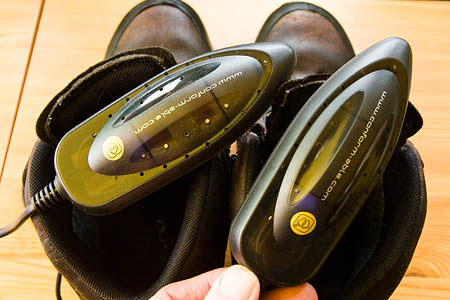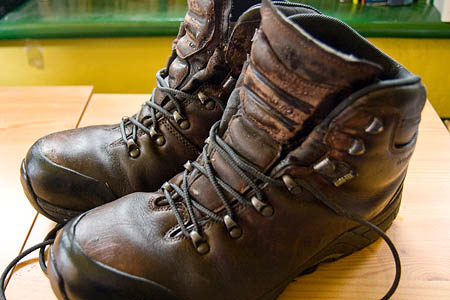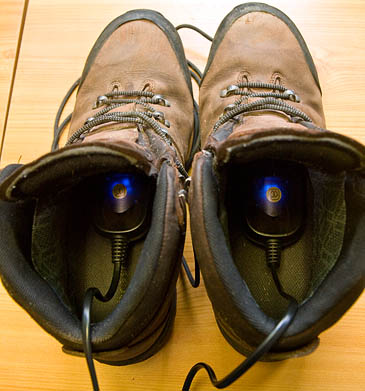Sidas Drywarmer boot drying system
Price: £25
Country of manufacture: China
Let’s face it: wet boots are pretty much unavoidable for British walkers.
Anyone waiting for fine weather to get out into our countryside could be waiting for a long time.
Soggy bogs; torrential downpours, stream crossings. They all mean one thing: your boots will get wet.
If you’re on a multi-day trip in the wilds, you don’t have much choice but to put the wet footwear back on and put up with it. But most walks into the country and on to our hills are day trips so, back at home, we can start drying out our boots.
Manufacturers tell us not to do this using fierce heat; it risks cracking leather or damaging fabrics if the footwear is dried too rapidly.
External drying of modern boots that have a waterproof membrane can also leave the interior still wet as the moisture is trapped inside the footwear.
Traditional methods include stuffing them with newspaper and then repeating a few hours later.
But now there’s a more technological approach.
Sidas’s Drywarmer boot warming system uses two electrical inserts which provide gentle heat to dry wet boots from the inside.
The inserts are linked to a single plug which goes into an electrical socket. It’s all very simple: stick them in the boots; plug them in; go and do something useful for the next few hours, such as getting the map out and planning your next outing.
We put the Drywarmer to test on a pair of boots that had been thoroughly soaked in a hillwalking trip in the Yorkshire Dales.
The two units each have a small ultra-violet lamp too, which Drywarmer says helps kill the odour-producing bacteria that infest damp footwear.
The Nubuck boots were very wet after a day in torrential rain. French company Sidas says the Drywarmer heating elements, which reach 50C, should be left in for at least three hours.
In practice, though the boots showed signs of starting to dry after that time, we found a more realistic way of using them is to leave the Drywarmers in overnight. In the morning, the boots were completely dry.
Although the unwelcome foistiness was diminished, the odour hadn’t completely gone. Perhaps a few uses will see the whiffiness decline further.
The UV light is not bright: less than 55 millicandela, so don’t expect a suntan, but it does give a useful instant indication the warmers are plugged in and working.
Power consumption of the Drywarmer is 12W, so it will cost about the same as leaving on a typical energy-saving lightbulb overnight.
For obvious reasons, boots should be emptied of any actual water before putting the Drywarmer in, and the elements are for indoor use only.
For any habitual walker in the British countryside sick of using half a forest’s worth of newspaper after every trip, the Drywarmer, at £25 a pair, could be a worthwhile investment.
The elements are small enough to use on shoes too, so if you get caught in an unexpected downpour while out shopping, the Drywarmer will double up to treat your everyday footwear.
More details are on the Sidas website.



Timothy Geniac
13 November 2012Very well written article, indeed! Very informative! Too bad the sidas website us a bit of a pain to navigate on a smartphone, otherwise I'd have two of these babies ordered up for my horse farming parents as Christmas gifts, as it seems they have everything under the sun, save some nice UV boot dryers for their snow covered boots that oftentimes reek of manure...hopefully they are available on Amazon.com soon!
Cheers,
Timothy.
Bob
14 November 2012A company spokesman said: “I know retailers like Snow + Rock and Wiggle stock the drywarmer but they haven't got them on the website yet, with this in mind the easiest way of buying online is via Ellis Brigham:
http://www.ellis-brigham.com/products/drywarmer/5617”
Bob Smith
Editor
Jayne
22 November 2012I use the Drywarmers in hiking and cycling shoes. If the shoes are sodden I stuff them with newspaper for a few minutes to soak up most of the water and then use the Drywarmers.
Brilliant bit of kit!
I got mine from Needle Sports in Keswick:
http://www.needlesports.com/Catalogue/Accessories/Proofings/Drying-Machines
Jen
24 January 2014Hi, i bought these for my boyfriend who loves going walking and his boots always get soaking.
From the article we thought that if we left them in overnight they would be bone dry... i don't know if we're doing something wrong but they don't seem to make any difference. The light is on but they only feel slightly warm.
Does this sound right or are they not working?
Bob
24 January 2014In my experience, after a while, the Drywarmers should feel a bit hotter than 'only slightly warm'. After being plugged in for a short period, they definitely feel fairly hot. Not untouchable but certainly warmer than you're describing Jen.
Bob Smith